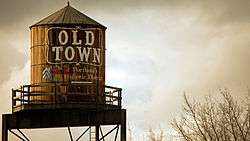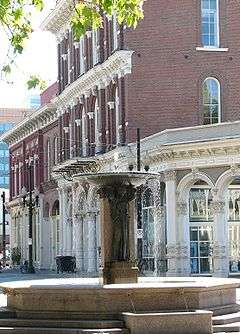Old Town Chinatown, Portland, Oregon
| Old Town Chinatown | |
|---|---|
| Neighborhood | |
 | |
 Old Town Chinatown | |
|
Coordinates: 45°31′31″N 122°40′21″W / 45.52528°N 122.67246°WCoordinates: 45°31′31″N 122°40′21″W / 45.52528°N 122.67246°W PDF map | |
| Country | United States |
| State | Oregon |
| City | Portland |
| Government | |
| • Association | Old Town Chinatown Neighborhood Association |
| Area[1] | |
| • Total | 0.20 sq mi (0.53 km2) |
| Population [2] | |
| • Total | 3,922 |
| Housing[2] | |
| • Occupancy rate | % occupied |
| • % households renting | % renting |
| • Avg. household size | persons |
Old Town Chinatown is the official Chinatown of the Northwest section of Portland, Oregon. The Willamette River forms its eastern boundary, separating it from the Lloyd District and the Kerns and Buckman neighborhoods. It includes the Portland Skidmore/Old Town Historic District and the Portland New Chinatown/Japantown Historic District, which are listed on the National Register of Historic Places.
In the Northwest section, NW Broadway forms the western boundary, separating it from the Pearl District, and W Burnside St. forms the southern boundary, separating it from Downtown Portland. In the Southwest section, the neighborhood extends from SW 3rd Ave. east to the river and from SW Stark St. north to W Burnside St. (with the exception of areas south of SW Pine St. and west of SW 2nd Ave, and south of SW Oak St. and west of SW 1st Ave., which are part of Downtown).
Transportation
The neighborhood is well-served by various modes of transportation. Amtrak's Union Station and the Greyhound bus station are located in the northwestern portion of the neighborhood. The Broadway Bridge marks the northern tip, and the ends of the Steel and Burnside bridges are along the area's eastern border.
The MAX Light Rail line turns south into the neighborhood from the Steel Bridge and stops at Old Town/Chinatown, Skidmore Fountain, and Oak Street/Southwest 1st Avenue; the system connects the neighborhood to Northeast and North Portland across the Willamette, and to Downtown Portland to the south and west. The Portland Mall begins at the Greyhound station, providing local bus and light rail service along 5th and 6th Avenues south into downtown.
Old Town

|
Portland Skidmore/Old Town Historic District | |
|
Skidmore Fountain, and the New Market Block in the background. | |
  | |
| Location | Roughly bounded by Naito Parkway, Everett, 3rd, and Oak streets., Portland, Oregon |
|---|---|
| Area | 440 acres (180 ha)[3] |
| Built | Approx. 1871-1914 |
| Architect | multiple |
| Architectural style | Late 19th and Early 20th Century American Movements, Late Victorian, Italianate |
| NRHP Reference # | 75001597 |
| Significant dates | |
| Added to NRHP | December 6, 1975[4] |
| Designated NHLD |
May 5, 1977[5] October 6, 2008 (additional NHL documentation approved) |
Old Town was the original urban core of Portland. It straddles West Burnside St and includes an area under the Burnside Bridge. The Portland Skidmore/Old Town Historic District, created in 1975 and roughly bounded by Naito Parkway, Everett Street, 3rd Avenue, and Oak Street, is an important part of Old Town Portland. Attractions include the Saturday Market; the Shanghai tunnels; and Ankeny Plaza, site of Portland's oldest public art work, the Skidmore Fountain (dedicated September 22, 1888). The fountain, designed by Olin L. Warner of New York, is named after pioneer druggist Stephen G. Skidmore. Naito Parkway (ex-Front Avenue) is named after the late Bill Naito, a longtime Old Town-based businessman and developer, who with his brother Sam Naito in the 1960s helped to halt the decline of the area—then known as Portland's "Skid Road"—by opening a retail store, buying and restoring old buildings in the area, and convincing others to invest in the district over the next several years.[6] Bill Naito died in 1996.
Businesses located in Old Town include Dan and Louis Oyster Bar (in the same location since 1907) and Voodoo Doughnut. The area is the site of the 24 Hour Church of Elvis and formerly of attractions such as the Satyricon nightclub and the X-Ray Cafe.
The Portland Skidmore/Old Town Historic District was declared a National Historic Landmark in 1977.[5][7]
Chinatown
|
Portland New Chinatown/Japantown Historic District | |
|
The Chinatown Gate over NW Fourth Avenue at W Burnside Street. | |
  | |
| Location | Portland, Oregon |
|---|---|
| Area | 174 acres (70 ha)[3] |
| Built | Apx. 1880-1927 |
| Architect | multiple |
| Architectural style | Late Victorian, Modern Movement, Late 19th And Early 20th Century American Movements[3] |
| NRHP Reference # | 89001957 |
| Added to NRHP | 1989-11-21[4] |
The Chinatown portion of Old Town extends north from West Burnside St. to Union Station. The entrance is marked by a China gate (built in 1986),[8] complete with a pair of lions, at the corner of NW 4th Ave. and W Burnside St. The core of the area, from W Burnside St. to NW Glisan St. and from NW 5th Ave. to NW 3rd Ave., was designated in 1989 the New Chinatown/Japantown Historic District.
When compared to the more well-known West Coast Chinatowns of Oakland and San Francisco in California and Vancouver, British Columbia, Portland's Chinatown is smaller and less active. It has more than two dozen Chinese-owned businesses, including restaurants such as the Republic Cafe, which opened in 1922 and is Portland's oldest Chinese restaurant and Good Taste, which serves Cantonese noodle soups and barbecued meats, gift and import shops, club houses, an herbal medicine store and an Asian food market.
Other major organizations based in Chinatown include the Port of Portland, Oregon Department of Transportation's Portland offices and NW Natural Gas. There is also a parking structure with a helipad on top.
In a step towards revitalization of the area, the Lan Su Chinese Garden opened September 14, 2000. The $12.8 million park covers an entire city block and was built by 65 artisans from Suzhou, China of imported materials (though all plants were grown locally). More recently, NW 3rd and 4th Avenues received streetscape improvements, including plaques describing historical features. Two block-long "festival streets" that can easily be used for street festivals were also created between these streets.[9] In 2008, Uwajimaya anchored a redevelopment proposal, similar to the Uwajimaya Village in Seattle's Chinatown-International District. It would host the store, an underground parking garage, mixed-income apartments, and other small retailers. It was hoped to revitalize the area and bring in more tourists.[10] In August 2011, Uwajimaya decided not to put a store in Chinatown because its stores in downtown Seattle and Renton, Washington are not meeting their potentials.[11]
Prior to World War II, the area that is today called Chinatown was Portland’s Japantown. Beginning in the 1890s, many Japanese immigrants were processed through Portland, creating a demand for hotels, bathhouses, and other services. Businesses that formed in the city’s Japantown thrived in the low-rent areas near the river. Today the Japanese American Historical Plaza and the Oregon Nikkei Legacy Center in what is today Portland’s Chinatown serve as reminders of what was once Portland’s Japantown.[12]
Translation of street names
The street signs in Chinatown are both English and Chinese. The Chinese on the signs is written in traditional characters, and its pronunciation is Cantonese.
- W Burnside Street — 西本世街 — sai1 bun2 sai3 gaai1
- NW Couch Street — 西北葛珠街 — sai1 baak1 got3 zyu1 gaai1
- NW Davis Street — 西北戴維斯街 — sai1 baak1 daai3 wai4 si1 gaai1
- NW Everett Street — 西北愛和烈街 — sai1 baak1 ngoi3 wo4 lit6 gaai1
- NW Fifth Avenue — 西北第五街 — sai1 baak1 dai6 ng5 gaai1
- NW Flanders Street — 西北芬蘭達士街 — sai1 baak1 fan1 laan4 daat6 si6 gaai1
- NW Fourth Avenue — 西北第四街 — sai1 baak1 dai6 sei3 gaai1 (pictured)
- NW Glisan Street — 西北紀利臣街 — sai1 baak1 gei2 lei6 san4 gaai1
- NW Third Avenue — 西北第三街 — sai1 baak1 dai6 saam1 gaai1
See also
| Wikimedia Commons has media related to Skidmore/Old Town Historic District. |
- List of National Historic Landmarks in Oregon
- National Register of Historic Places listings in Multnomah County, Oregon
- Pensole
References
- ↑ communique.portland.or.us
- 1 2 Demographics (2000)
- 1 2 3 "National Register of Historic Places.com". Retrieved 2008-05-11.
- 1 2 National Park Service (2007-01-23). "National Register Information System". National Register of Historic Places. National Park Service.
- 1 2 "Skidmore/Old Town Historic District". National Historic Landmark summary listing. National Park Service. Retrieved 2007-11-19.
- ↑ Orloff, Chet. "William Sumio Naito (1925–1996)". The Oregon Encyclopedia. Retrieved December 4, 2010.
- ↑ Carolyn Pitts (February 19, 1977). "National Register of Historic Places Inventory-Nomination: Skidmore/Old Town Historic District" (pdf). National Park Service. and Accompanying 13 photos, from 1960 and 1975. (1.18 MiB)
- ↑ Hottle, Molly (February 2, 2011). "Chinese New Year celebration at Portland Chinatown gate also will celebrate its 25th anniversary". The Oregonian. Retrieved February 13, 2011.
- ↑ http://www.pdc.us/ura/dtwf/otctstreetscape.asp pdc.us
- ↑ Gunderson, Laura (July 1, 2008). "Sign in to OregonLive.com". The Oregonian.
- ↑ "Uwajimaya, citing economy, won't open store in Chinatown: Portland City Hall roundup". The Oregonian. August 1, 2011.
- ↑ Office of Congressman Earl Blumenauer. "About the District". Retrieved February 21, 2016.
External links
- Old Town/Chinatown information from Old Town Chinatown Neighborhood Association
- Self-Guided Walking Tour of Portland's Chinatown from Travel Portland
- National Historic Landmark Nomination for Skidmore/Old Town Historic District
- Portland's Chinatown History and Resources from Friends of Portland Chinatown




